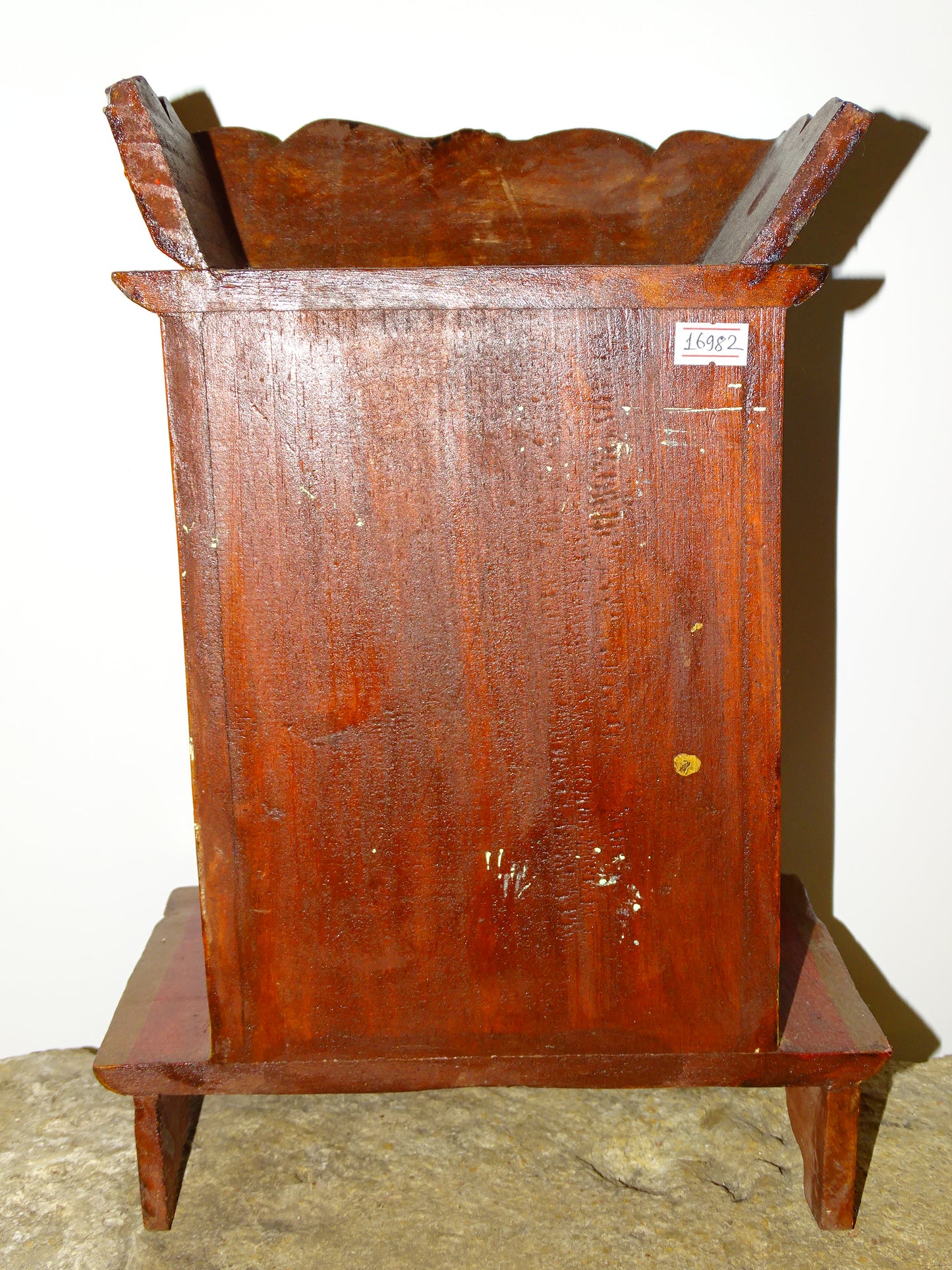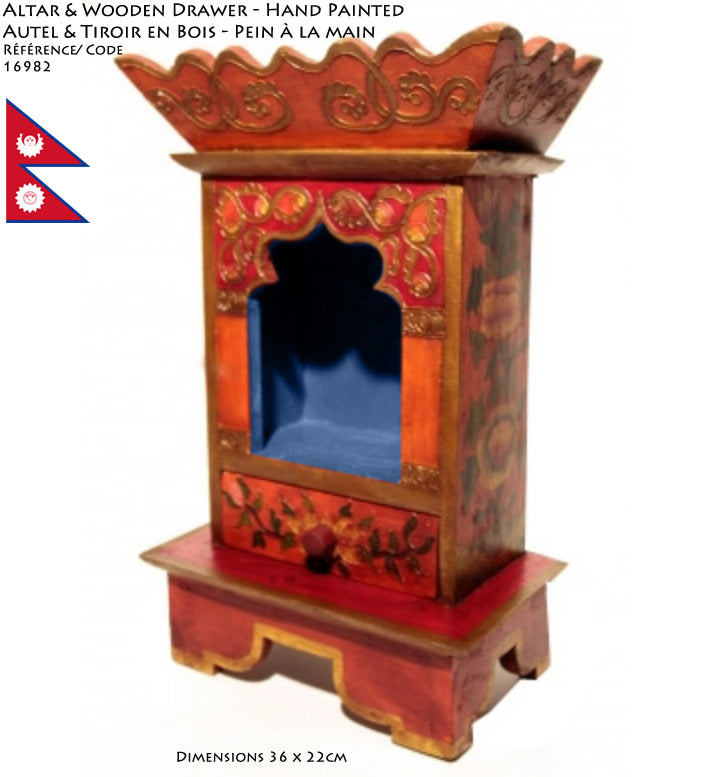Selection of wooden Buddhist altars with drawers 🛕 - Hand-painted in Nepal. 2 models to choose from: 16.5x22x14 cm or 36x22x9. Very good quality, typical patterns!
Selection of wooden Buddhist altars with drawers 🛕 - Hand-painted in Nepal. 2 models to choose from: 16.5x22x14 cm or 36x22x9. Very good quality, typical patterns!
Couldn't load pickup availability
- ✧─────✧
About the product:
🛕 Name/Type: Authentic altar with small drawer - Hand painted - The decorations appear antique and may show deliberately applied lesions; these are not defects.
All you have to do is find the perfect statuette to fit these colorful altars.
Items may vary slightly depending on arrival!
🌍 Origin: Nepal
📐 ⚖️ Dimensions:
- Code 16981: 16.5 x 22 x 14 centimeters
- Code 16982: 36 x 22 x 9 centimeters
⚖️ Weight:
- Code 16981: +/- 685 grams
- Code 16982: +/- 1346 grams
🧬 Material: Wood
📦 Packaging: Individually - Wrapped in paper
🎁 Ideal for giving as a gift or treating yourself!
🛕 History of the Wooden Buddhist Altar
🌏 Origins of the Buddhist altar (5th century BC – 1st century AD)
The Buddhist altar has its roots in ancient India, when the historical Buddha, Siddhārtha Gautama (circa 5th century BC), taught the path to spiritual liberation.
At that time, there was no representation of the Buddha in human form: the first Buddhist altars were very simple , often consisting of a small symbolic space around a stupa (reliquary), a lotus flower , or a bodhi tree — recalling the place where the Buddha attained enlightenment.
Around the 1st century AD , under the influence of Greco-Buddhist art from Gandhara (present-day Pakistan/Afghanistan), the first statues of the Buddha appeared. It was then that altars became spaces arranged around these images, gradually integrating wood as a construction or decorative material.
🪵 The rise of wooden altars: symbolism and craftsmanship (3rd – 9th century)
With the spread of Buddhism to the East, wood became the preferred material, particularly in regions where stone was rare or expensive.
- 3rd century : In China, during the Han dynasty, the first Buddhist temples were inspired by imperial wooden structures. They featured portable, carved altars where offerings and incense were placed.
- 7th century : In Japan, with the introduction of Buddhism via Korea, wooden Buddhist altars (called butsudan ) appear in noble houses and temples.
- 9th century : In Tibet and Nepal, artisans create richly decorated monastic altars , often inlaid with semi-precious stones, where thangkas , statues, and ritual objects are placed.
In all these cultures, wood is chosen for its warmth, its symbolism of life and renewal , and because it allows for fine and detailed carving of religious motifs (lotuses, dragons, clouds, mandalas, etc.).
🕯️ The altar as the spiritual center of the home (10th – 19th century)
As Buddhism spread throughout Asia, the wooden altar became not only a monastic element, but also a sacred place within the home .
- In China , we speak of fo jia (佛家): the domestic altar where we honor the Buddha, the ancestors and the protective deities.
- In Japan , the butsudan became an essential tradition: a lacquered wooden piece of furniture, often decorated with gold, containing an image of the Buddha, a sacred scroll ( ihai ) and ritual accessories (candles, incense, bells).
- In Thailand and Cambodia , wooden altars are placed high up to commemorate the respect due to Buddha; flowers, fruit and oil lamps are placed there.
These altars vary according to Buddhist schools (Theravāda, Mahāyāna, Vajrayāna), but their function remains the same: to create a space for recollection, gratitude and meditation .
🔥 Periods of repression and hidden symbolism (19th–20th century)
During certain periods in history—notably during the Cultural Revolution in China (1966–1976) and the repression of Buddhism in Tibet after 1959 —religious practices were banned.
Visible statues and altars were confiscated or destroyed.
The faithful then found ingenious solutions :
They made small folding or portable wooden altars , sometimes hidden in chests, drawers or behind doors. These miniature altars allowed the practice to continue in secret , in the manner of Tibetan portable thangkas .
Thus, wood, discreet and malleable, became a tool of spiritual resistance .
🌸 The modern Buddhist altar (20th – 21st century)
Today, the wooden Buddhist altar continues to evolve:
- In monasteries , it retains a traditional form, often monumental, carved in sandalwood or teak.
- In contemporary homes , it is simplified: a small piece of furniture, sometimes suspended, dedicated to daily meditation.
- In the West , with the spread of Zen and Tibetan Buddhism, many practitioners install minimalist altars in light wood, reflecting the sobriety and serenity of the practice.
Wood remains favored for its connection with nature and its ability to absorb light and the scent of incense , creating an atmosphere conducive to inner peace.
🕊️ Conclusion
The wooden Buddhist altar is much more than just a piece of furniture:
It is a bridge between the visible and the invisible , between the house and the temple, between man and Awakening.
From the Bodhi tree to the lacquered altars of Japan, from Tibetan craftsmanship to modern creations, it embodies the continuity of a living tradition , made of respect, beauty and inner silence.
- ✧─────✧
A question? A comment? | Order and delivery information
A question? A comment? | Order and delivery information
⋯⋯⋯⋯⋯⋯⋯⋯⋯⋯⋯⋯⋯⋯⋯⋯⋯⋯⋯⋯
📞 Customer service available from Tuesday to Saturday , from 10am to 7pm (French time)
- 🇫🇷 From France: 06 51 85 38 18
- 🌍 From abroad: +33 6 51 85 38 18
- 💬 Live chat: via the bubble in the bottom right corner of your screen
- 📧 Email : available 24/7 – we respond quickly!
⋯⋯⋯⋯⋯⋯⋯⋯⋯⋯⋯⋯⋯⋯⋯⋯⋯⋯⋯⋯
🔖 Order today and receive your package within 2 to 10 days depending on your continent.
💳 Secure payment & certified by SSL encryption 🔐
↩️ Returns & exchanges possible within 14 to 30 days after receipt.
🌍 Shipping costs are calculated automatically based on your shipping address at checkout.
📦 Country of shipment: France 🇫🇷
Share

























